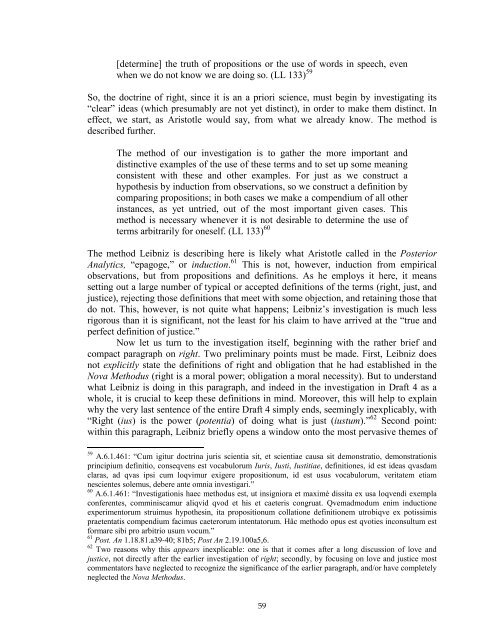Stony Brook University
Stony Brook University
Stony Brook University
You also want an ePaper? Increase the reach of your titles
YUMPU automatically turns print PDFs into web optimized ePapers that Google loves.
[determine] the truth of propositions or the use of words in speech, even<br />
when we do not know we are doing so. (LL 133) 59<br />
So, the doctrine of right, since it is an a priori science, must begin by investigating its<br />
“clear” ideas (which presumably are not yet distinct), in order to make them distinct. In<br />
effect, we start, as Aristotle would say, from what we already know. The method is<br />
described further.<br />
The method of our investigation is to gather the more important and<br />
distinctive examples of the use of these terms and to set up some meaning<br />
consistent with these and other examples. For just as we construct a<br />
hypothesis by induction from observations, so we construct a definition by<br />
comparing propositions; in both cases we make a compendium of all other<br />
instances, as yet untried, out of the most important given cases. This<br />
method is necessary whenever it is not desirable to determine the use of<br />
terms arbitrarily for oneself. (LL 133) 60<br />
The method Leibniz is describing here is likely what Aristotle called in the Posterior<br />
Analytics, “epagoge,” or induction. 61 This is not, however, induction from empirical<br />
observations, but from propositions and definitions. As he employs it here, it means<br />
setting out a large number of typical or accepted definitions of the terms (right, just, and<br />
justice), rejecting those definitions that meet with some objection, and retaining those that<br />
do not. This, however, is not quite what happens; Leibniz’s investigation is much less<br />
rigorous than it is significant, not the least for his claim to have arrived at the “true and<br />
perfect definition of justice.”<br />
Now let us turn to the investigation itself, beginning with the rather brief and<br />
compact paragraph on right. Two preliminary points must be made. First, Leibniz does<br />
not explicitly state the definitions of right and obligation that he had established in the<br />
Nova Methodus (right is a moral power; obligation a moral necessity). But to understand<br />
what Leibniz is doing in this paragraph, and indeed in the investigation in Draft 4 as a<br />
whole, it is crucial to keep these definitions in mind. Moreover, this will help to explain<br />
why the very last sentence of the entire Draft 4 simply ends, seemingly inexplicably, with<br />
“Right (ius) is the power (potentia) of doing what is just (iustum).” 62 Second point:<br />
within this paragraph, Leibniz briefly opens a window onto the most pervasive themes of<br />
59 A.6.1.461: “Cum igitur doctrina juris scientia sit, et scientiae causa sit demonstratio, demonstrationis<br />
principium definitio, conseqvens est vocabulorum Iuris, Iusti, Iustitiae, definitiones, id est ideas qvasdam<br />
claras, ad qvas ipsi cum loqvimur exigere propositionum, id est usus vocabulorum, veritatem etiam<br />
nescientes solemus, debere ante omnia investigari.”<br />
60 A.6.1.461: “Investigationis haec methodus est, ut insigniora et maximè dissita ex usa loqvendi exempla<br />
conferentes, comminiscamur aliqvid qvod et his et caeteris congruat. Qvemadmodum enim inductione<br />
experimentorum struimus hypothesin, ita propositionum collatione definitionem utrobiqve ex potissimis<br />
praetentatis compendium facimus caeterorum intentatorum. Hâc methodo opus est qvoties inconsultum est<br />
formare sibi pro arbitrio usum vocum.”<br />
61 Post. An 1.18.81.a39-40; 81b5; Post An 2.19.100a5,6.<br />
62 Two reasons why this appears inexplicable: one is that it comes after a long discussion of love and<br />
justice, not directly after the earlier investigation of right; secondly, by focusing on love and justice most<br />
commentators have neglected to recognize the significance of the earlier paragraph, and/or have completely<br />
neglected the Nova Methodus.<br />
59
















